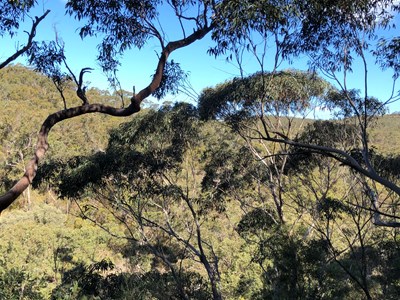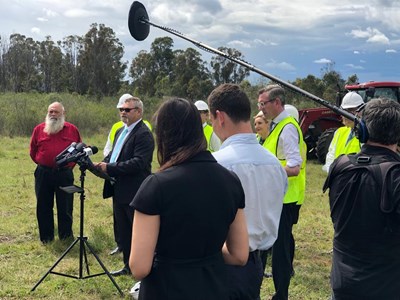Our Story
The Gandangara Local Aboriginal Land Council was established in 1984, following the passage of the Aboriginal Land Rights Act of 1983 (New South Wales). We are one of 120 Local Aboriginal Land Councils in NSW.
As a part of Greater Western Sydney, we are home to the largest and most diverse urban First Nations population in Australia. Our First People come from a wide range of regions, clans, families and language groups. The staff and services at Gandangara reflect this diversity. We are dedicated to promoting unity, cooperation and shared opportunity for all of us.
Our boundaries span, in whole or in part, six Local Government Areas in the South Western Sydney region. These include Liverpool, Fairfield, Canterbury-Bankstown, Parramatta, Cumberland and the Sutherland Shire. We are the largest single landowner in the Sutherland Shire.
We own and manage 28 residential rental properties and 3 businesses: Gandangara Health Services, Marumali and Gandangara Transport Services.
Our organisation has made claims on a total of 4,700 hectares of land, winning our claim for 1,100 hectares at Heathcote Ridge, where our Local First Nations Ranger program now operates. Other claims are still pending.
Unbroken lines of First People
Aboriginality
Our Aboriginality connects us, gives us our sense of belonging and helps us thrive. Family, Country and neighbour are the unbroken lines of our Aboriginality. Our attitudes and behaviour towards ourselves and others, passed down through history, best define our Aboriginality.
Family
Family is the heartbeat of every clan and Country. Mother Earth is the centre of every family, every clan. She gives us all life, loving and nurturing us equally. In return, we respect, love and nurture each other.
Country
Our land, our Country, is the source of life. Mother Earth feeds us. She teaches us. She protects us. We flourish and endure because of her. In return, we care for Mother. We manage her, cultivate her and dance for her. Today, we continue to be the land’s custodians, fighting to protect and preserve our Mother Earth.
Neighbours
In the beginning, there were no fences and no artificial boundaries to separate us. We shared the land with everybody. We may have lived apart, with different languages and customs, but we respected each other’s regions and differences. We were as diverse as the land we lived on, but came together regularly to share and trade. This is a tradition we continue today — sharing with our neighbours, respecting our differences and embracing our diversity. This is one of the reasons we are the world’s longest-surviving culture.
Protecting First People
We protect and promote the enduring knowledge of what it means to be Australia’s First People every day. This keeps the unbroken lines strong, following the same practical values and principles that we as First People have lived by and embraced from the beginning.
Our work at Gandangara contributes to the health and well-being of our members and the wider community. We improve, empower and transform individual lives for the better. Our pride in our Aboriginality makes the work we do at Gandangara so personal for us all.
Family
Everyone who works with or at Gandangara is considered family and treated that way. We come from the same Mother Earth. We’ve shared the same joys, pains and love. Given the suffering and deprivation we have endured, we must be among the most loving people on Earth to still be here and offer our hand in friendship.
When our ancestors lived on the land, they shared and protected each other to endure and thrive. Nothing has changed for us. At Gandangara, family is what matters most, regardless of its size, shape or problems.
Country
When we gain custody of our land, we take it very seriously. We invest significant time and money in repairing and restoring it to its natural state. We respect this precious asset for our ancestors, our members and to provide a secure legacy for our children.
We continue to fight in the courts and parliament to retain and regain more of our lands and ensure our inalienable right to own them. Through our efforts, our land holdings continue to grow in value and size.
Neighbours
We build respectful working relationships with local city councils, government departments, other organisations and businesses for mutual benefit. We promote First Nations history and culture in schools to nurture understanding and respect. We meet regularly with our members to hear their feedback and needs. We formulate this as part of ourCommunity, Land and Business Plan.
These are our modern-day corroborees, which echo the regular meetings and gatherings of our ancestors. They respected differences and shared their wisdom freely, in a spirit of unity, openness and for mutual benefit. Our members and our community grow and thrive because we follow this path.
Promoting peace
Peace is much more than the absence of hostility. Peace is the active presence of conscious goodness and kindness. We provide our members and the community with practical help, advice and counselling to restore peace in their lives.
If we are truly proud of being the First People, then we must think, act and live as the First People did regarding our family, clan, country and neighbours.
Drop down sections
Jump to Community Land and Business Plan
At Gandangara we work hard at putting valuable meaning to our name, by what we stand for and what we do for our Members. This is important because the outcome transcends legal obligations and resonates beyond our walls. Names bring with them certain perceptions and even expectations depending on the reputations that have been built around them. Gandangara has built for itself a fine reputation of integrity, honesty, trustworthiness, respect and successful, accountable management. That’s the ‘name’ we all value and cherish.
Our literal name ‘Gandangara’ does not refer to the Traditional Custodians of the area within this jurisdiction. Definitively identifying the traditional owners or custodians of the land in our region is fraught with difficulty, from both the perspective of historical sources and the contemporary perspective of identity politics and language revivalism.
Previous GLALC company documents and external publications assert that – ‘The original owners of the land of our region are the Darug Nation, and particularly the Cabrogal Clan, whom we acknowledge, and to whose Elders and ancestors we pay deep respect.’ (Board tenure 2011 -2015)
Information and historical records about the Traditional Owners have come from early colonists and ethnographers observing Aboriginal people. Historical records are based on the lens of settler colonialism as found in the records of the early colonists (especially Watkin Tench, William Dawes and David Collins). The difficulty is compounded by the devastation and disenfranchisement inflicted upon the First Peoples of the Sydney area.
Academic scholarship on the topic of Traditional Owners, in the South Western Sydney area, is scant. Frequently cited sources include Kohen ( 1993 - although his work is controversial and not based on consensus) along with Attenbrow (2003) Dreher (2006) and Gapps (2010).
Most of these sources acknowledge the traditional Country and language as being ‘Darug’ and the clan of the Cabramatta region as being ‘Cabrogal’ (or Gabrogal) Because of contemporary politics of representation, around the history (and the current revivalism) of the Darug language, we tend to focus on recognising the families within the Cabrogal clan as the traditional custodians of the land.
Existing research also postulates that the historical connection of the Cabrogal clan, as being original to the South Western Sydney area, can be seen in the ‘Cabra’ prefixes on place names such as Cabramatta, and the name of the Cabrogal grub, a woodworm whose provenance is the Cumberland plains. Historians note that a ‘clan’ of Aboriginal people was an extended family of up to around 60 persons and that the Cabrogal (also recorded as Ga-bro-gal or Cobrakall between the 1790s and 1800s) were the clan group original to the Cabramatta creek areas.
Today, there are no descendants of this historical clan recorded on the Register of Aboriginal Owners for the Gandangara Local Aboriginal Land Council area, or its membership under the Office of the Registrar, ALRA 1983 (NSW). As such, today the Gandangara Local Aboriginal Land Council community is a multicultural collection of Aboriginal persons from many different families, clans, tribal and nation groups, from many different countries.
We acknowledge the families of the Cabrogal clan as the Traditional Custodians of this land. We act as the statutory custodians of the Aboriginal persons living in this land. We honour our Elders past, present and emerging. More research needs to be conducted, incorporating the Local Aboriginal perspectives, in the accurate construction of this history.








